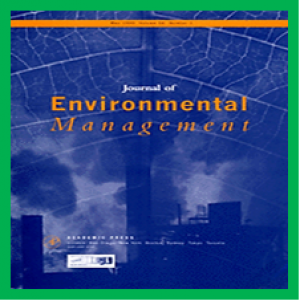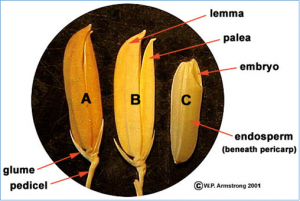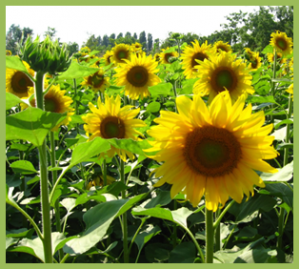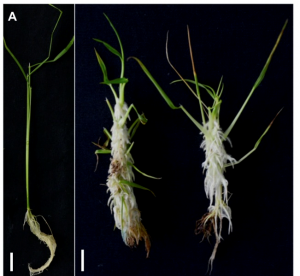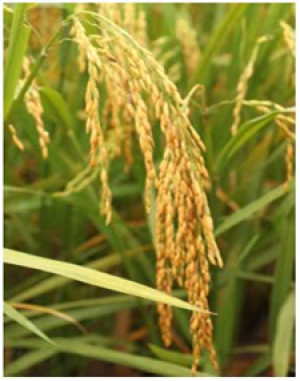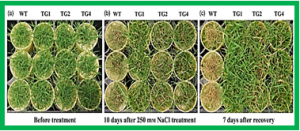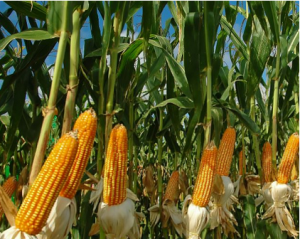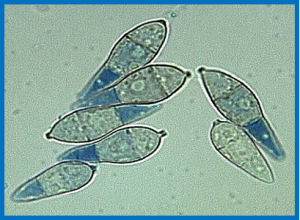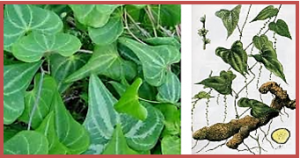The individual and mutual effects of substrate concentration (from 0.8 to 9.2 g/L) and pH (from 4.6 to 7.4) on hydrogen and volatile fatty acids production from sugarcane bagasse (SCB) were investigated in batch reactors, using a response surface methodology (RSM) and central composite design (CCD). The maximum of 23.10 mmoL H2/L was obtained under optimized conditions of 7.0 g SCB/L and pH 7.2, at 37 °C through the acetic acid pathway (1.57 g/L).
Brown stem rot (BSR), caused by the fungus Phialophora gregata, reduces soybean yield by up to 38%. While three dominant resistance loci have been identified (Rbs1-Rbs3), the gene networks responsible for pathogen recognition and defense remain unknown. Further, identification and characterization of resistant and susceptible germplasm remains difficult.
Rice hulls consist of two bract-like structures, the lemma and palea. The hull is an important organ that helps to protect seeds from environmental stress, determines seed shape, and ensures grain filling. Achieving optimal hull size and morphology is beneficial for seed development. We characterized the split-hull (sph) mutant in rice, which exhibits hull splitting in the interlocking part between lemma and palea and/or the folded part of the lemma during the grain filling stage.
The rust virulence gene is co-evolving with the resistance gene in sunflower, leading to the emergence of new physiologic pathotypes. This presents a continuous threat to the sunflower crop necessitating the development of resistant sunflower hybrids providing a more efficient, durable, and environmentally friendly host plant resistance. The inbred line HA-R8 carries a gene conferring resistance to all known races of the rust pathogen in North America and can be used as a broad-spectrum resistance resource.
A well-developed root system in rice and other crops can ensure plants to efficiently absorb nutrients and water. Auxin is a key regulator for various aspect of root development, but the detailed molecular mechanisms by which auxin controls crown root development in rice are not understood. We show that overexpression of a YUC gene, which encodes the rate-limiting enzyme in auxin biosynthesis, causes massive proliferation of crown roots.
Metal tolerance proteins (MTPs) belong to the cation diffusion facilitator family (CDF) and have been implicated in metal transport and homeostasis in different plant species. Here we report on the rice gene OsMTP11 that encodes a putative CDF transporter that is homologous to members of the Mn-CDF cluster. The expression of OsMTP11 was found to enhance Mn tolerance in the Mn-sensitive yeast mutant pmr1. Knockdown of OsMTP11 resulted in growth inhibition in the presence of high concentrations of Mn, and also led to increased accumulation of Mn in the shoots and roots.
MicroRNA393 (miR393) has been implicated in plant growth, development and multiple stress responses in annual species such as Arabidopsis and rice. However, the role of miR393 in perennial grasses remains unexplored. Creeping bentgrass (Agrostis stoloniferaL.) is an environmentally and economically important C3 cool‐season perennial turfgrass. Understanding how miR393 functions in this representative turf species would allow the development of novel strategies in genetically engineering grass species for improved abiotic stress tolerance.
Bio-fortification of maize with elevated Zinc (Zn) and Iron (Fe) holds considerable promise for alleviating under-nutrition among the world’s poor. Bio-fortification through molecular breeding could be an economical strategy for developing nutritious maize, and hence in this study, we adopted GWAS to identify markers associated with high kernel-Zn and Fe in maize and subsequently validated marker-trait associations in independent bi-parental populations.
Rice blast caused by phytopathogen Magnaporthe grisea poses a serious threat to the global food security and is difficult to control. Bacillus species have been extensively explored for the biological control of many fungal diseases. In the present study, marine bacterium Bacillus subtilis BS155 showed a strong antifungal activity against M. grisea The active metabolites were isolated and identified as cyclic lipopeptides (CLPs) of the fengycin family
Dioscorea zingiberensis is a major pharmaceutical plant that produces diosgenin, an important starting material for steroidal hormones. To date, no genome editing approach in D. zingiberensis has been reported. The clustered regularly interspaced short palindromic repeats (CRISPR/Cas9) system has proven to be an efficient targeted genome modification tool and has been successfully applied in many plants, including rice, soybean, wheat, and Arabidopsis.


 Curently online :
Curently online :
 Total visitors :
Total visitors :
